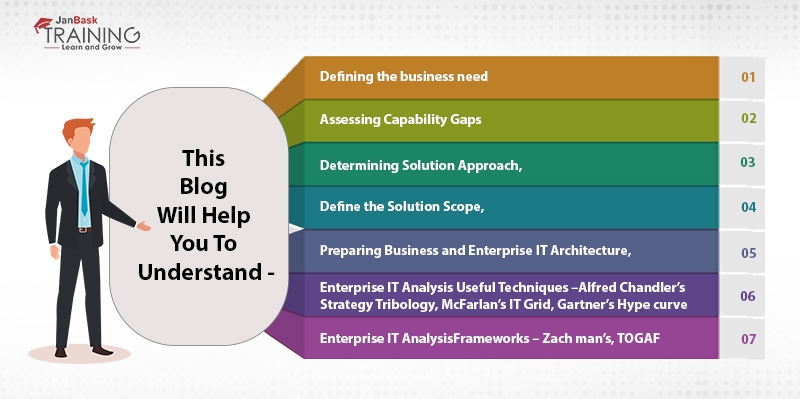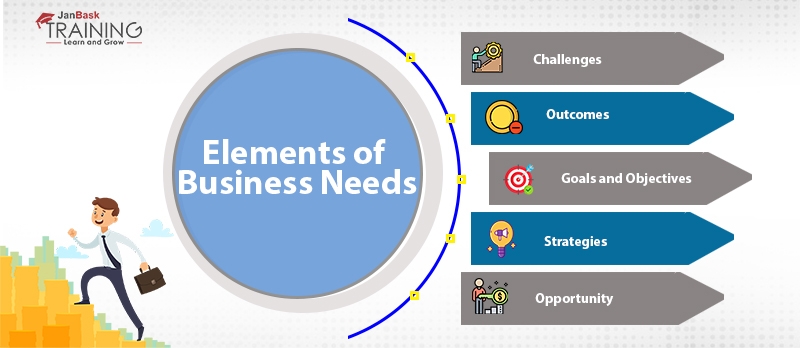09
JanYear End Sale : Get Upto 50% OFF on Live Classes + $999 Worth of Study Material FREE! - SCHEDULE CALL
IT Enterprise Analysis is so vast that it has multiple levels and it takes immense dedication to grasp it completely. Our blog on its basic level would help you to understand the initial journey of enterprise analysis. Let’s take a deep dive into the IT Enterprise Analysis.

Any business runs on two states - first being the current state and the future state. To reach a demanded and needed future state, gaps are identified which in turn becomes business needs. Thus, business needs can be defined as gaps between the current and future state of any business.
Business needs are an important element of enterprise analysis as it focuses on business goals. Business needs analysis requires understanding the goals of an organization and deriving a strategic plan to fulfill it. It requires critical thinking with an open mindset to visualize an organization’s success parameters, market challenges, and any sudden or known problems.
Important Elements of Business Needs are -

While analyzing business needs, any business analyst should document answers to the following questions -
As the name suggests, assessment of capability gaps means, checking on the capability of current business and the gaps that are preventing it to achieve a certain business goal. It has two aspects -
In any enterprise, capability gap analysis is being done on the basis of capability maps. Capability Map can be defined as the enterprise model which connects business capabilities, processes, and functions together to reach a particular business needs.
Steps to perform capability gap analysis -
Have you thought on what basis the solution approach would be defined in any enterprise?
The basis is high-level business need, business objectives, and business requirement which forms the building blocks for the solution approach.
Read: Business Analytics Course Syllabus: A Comprehensive Overview of Key Topics & Skills
The solution approach would be the approach mechanism which would be applied to reach the level of new capabilities. To finalize the solution approach it is important to analyze all the possible approaches, determining the processes and the methodologies, and making an assessment of whether an organization is capable to implement those solutions.
The two most widely used mechanisms are Agile Methodology and Change Management.
When a business analyst thinks through the possible approaches, he/she first tries to understand and analyze what is existing in the organization. Let’s see the approaches which are being analyzed at the first level -
The solution approaches in any enterprise analysis runs through some technical mechanism. These are -

Now that we have learned details on the solution approach, let’s see how solution scope is derived through it.
The solution scope is the final agreed decision made by all the stakeholders about the features which are going to be implemented for the particular business enhancement. For example - An organization is expanding and it needs to have an exponential solution to store its data. Here once the approach is finalized, a scope would be laid out that what all needs to be implemented at the first phase to get this delivered.
The solution scope can be static or could be dynamic based on the way organization functions. If it is dynamic, the solution scope might change throughout the project based on the business needs and requirements. A Subject Matter Expert plays a vital role in finalizing the solution scope as to what is suitable for implementation.
Details of solution scope are -
Business and Enterprise Architecture is a process by which organizations set protocols for their IT infrastructure and align it with their business goals. It is a continuous practice of analyzing, planning, designing, and implementing enterprise analysis to reach successful business goals.
Detailed planning is needed to build IT Architecture, otherwise it does not work out. Building a complete IT infrastructure that supports entire business needs is not easy, but that does not mean it should be done in bits and pieces.
The preparation of IT architecture needs to be done as per the latest running technology in the market so that the business product is always scalable and results in higher efficiency.
Read: 10 Best Power BI Project Ideas To Boost Your Skills
Let’s check out the steps involved in building enterprise IT Architecture -

IT Enterprise analysis has some of the very useful techniques which help to provide prominent results for business goals. Let’s see each one of them -
Alfred DuPont Chandler Jr. was a business history professor at Harvard Business Schools and Johns Hopkins University, who worked towards the scale and management structure of modern corporations, redefined business and economic history.
As per Alfred Chandler’s Strategy, “Structure follows Strategy”.
However, it is not that simple, Strategies and Structures have complex relationships through human interactions. And, when human actions and interactions come into the picture, they play a vital role in determining the intended and unintended consequences on business goals.
As per Alfred Chandler, the four sequential stages are -
McFarlan’s IT Grid depicts the visualization of strategies between IT strategy, business strategy, and operations. This grid helps to perform impact analysis between existing IT applications and demanding future applications. This model helps to understand the type of projects that an organization has, and how well it supports business strategies and operations.
It revolves around four factors -
The GRID diagram would explain it much better -
Gartner’s Hype curve
Whenever there is a new technology in the market, it is difficult to sense its potential at one go. The promises which it makes needs to be analyzed and checked as how much they are being hyped. Gartner’s Hype curve helps to analyze any new technology and provides a graphic representation of maturity and adoption of technology and applications. It also helps to solve the problem as to how new technologies are helpful in solving real business problems.
The graphical representation shows five phases which are determined as what is expected out of new technology and how much time it would take for its maturity.
Read: Top 11 Business Analytics Tools to Know About In 2025
Five Phases are -
Now that we have taken a close look at the architecture, let’s see the IT analysis framework. Actually, the IT Analysis framework is derived from the architecture that is being finalized. The framework revolves around five models -
TOGAF and Zachman Framework are two most widely used Enterprise Analysis Framework.
TOGAF is an enterprise architecture framework that has helped organizations to improve business efficiency. In TOGAF, architecture has two contextual explanation -
It revolves around principles governing architectural design and evolutions, by forming an iterative process model and reusing the existing architectural assets.
Zachman Framework is a two-dimensional classification of an enterprise that is represented in the form of the matrix. The matrix consists of 36 cells each of them representing one aspect of the enterprise.
Rows represent the viewpoint of stakeholders in the format of W5H i.e ‘what’, ‘where’, ‘who’, ‘when’, ‘why’, and ‘how’.
The columns represent a set of artifacts from the viewpoint of a group of stakeholders.
If Zachman Framework is completely implemented in any organization, then it describes everything that an organization does in an exhaustive manner.
Conclusion
It takes time to clearly understand all the concepts of IT Enterprise Analysis and put it through its implementation. But the concepts mentioned above surely take organizations towards successful business growth. I hope you had a great learning experience with us.
Increase Knowledge, Share Information and Happy Learning!!
Read: What is a Business Impact Analysis and Its Purpose?
 Pinterest
Pinterest
 Email
Email
The JanBask Training Team includes certified professionals and expert writers dedicated to helping learners navigate their career journeys in QA, Cybersecurity, Salesforce, and more. Each article is carefully researched and reviewed to ensure quality and relevance.

Cyber Security

QA

Salesforce

Business Analyst

MS SQL Server

Data Science

DevOps

Hadoop

Python

Artificial Intelligence

Machine Learning

Tableau
Search Posts
Related Posts
How to Make Successful Career as Business Analyst in UK?
![]() 6.3k
6.3k
10 Best Power BI Project Ideas To Boost Your Skills
![]() 2k
2k
Business Analyst Resume Sample Template For Beginner & Experienced
![]() 619.6k
619.6k
Top 100 Business Analyst Interview Questions And Answers
![]() 194.6k
194.6k
Discovering the Underlying Competencies of Business Analyst
![]() 6.4k
6.4k
Receive Latest Materials and Offers on Business Analyst Course
Interviews